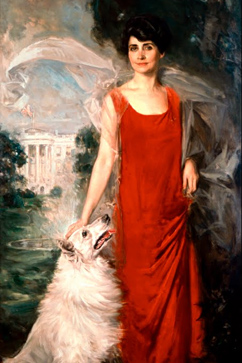Google Art Project and White House Launch 360 Tour of 'People's House'

Howard Chandler Christy/White House Collection
There's a cool new way to tour the White House from the comfort of the Internet.
The First Lady's office announced today the White House has partnered with the Google Art Project to create a virtual, Google Maps-like tour of the president's residence, as a part of what the Obama administration is describing as efforts to increase the accessibility and transparency of the goings-on at the historic home.
Michelle Obama filmed a welcome video for the online tour in which she stresses the White House's role as "the people's house."
The tour explores the White House's public rooms, halls and famous artworks, but only a small selection of rooms get the 360-degree Google Street View treatment. Users can browse a wide variety of international treasures in high resolution, whether artwork, the gilded sconces in the hallways of the White House, or samples of Lenox and Haviland china acquired during the presidencies of Ulysses S. Grant and Abraham Lincoln to Theodore Roosevelt and Bill Clinton. The U.S. Grant soup bowl features orange flowers instead of a state seal.
There is a circa 1799 steel and mother-of-pearl saber, a 1918 bronze sculpture of charging cowboys by Frederic Remington, a 1952 John Martin Oil on Canvas painting called "The Circus No. 1," and a 1912 John Singer Sargent painting of a woman lying under a translucent black shroud called "The Mosquito Net." It was given to the White House in 1964 by Whitney Warren in memory of John F. Kennedy.
Each piece is accompanied by an explanation on the site. The saber, for instance, was "Commissioned by the French volunteers who had served in the American Revolution for George Washington, but not presented prior to his death." It was not delivered to the U.S. government until 1933.
But the collection on display on Google consists largely of portraits of presidents, First Ladies, and a few Native Americans.
Some are iconic images, like the one by Aaron Shikler of Kennedy, arms crossed, looking down. Another is the 1835 Ralph Easter Whiteside Earl portrait of Andrew Jackson wearing a bold red collar.
One photo of a former First Lady stands out among the White House's vast collection of decorative pieces and iconic paintings on virtual display. Grace Coolidge, wife of former president Calvin Coolidge and First Lady of the United States from 1923 to 1929, often dressed in bright, vivid colors while living at the White House. In her White House portrait, she wears a red sleeveless flapper dress, and stands next to a large white dog. There are two versions of the portrait, one shows Coolidge on a white background with softer lines. The other features her in the same outfit and pose, but on the White House lawn. Both are by Howard Chandler Christy and from 1924.
But the description paired with Mrs. Coolidge's White House portrait leaves out some key details of the tale behind the painting. As the story goes, the artist selected a red dress for the first lady to wear, but President Coolidge preferred a white dress. The artist wanted the dress to contrast with the dog, to which the president retorted, "Dye the dog!"
"Coolidge was very picky about Grace's clothes," Feather Schwartz Foster, author of " The First Ladies," told ABC News. "She always thought he took more interest in her clothes than she did."
During the Jazz Age, flapper girls helped popularize "risque" sleeveless gowns and dresses, often the subject of snide remarks and criticism before the decade known as the Roaring Twenties.
"The 1920s coincided with a huge boom of pop culture," Foster said, "and Grace was very popular and progressive," citing her work as an instructor with a school for deaf students.
After the war, first ladies Mamie Eisenhower and fashion icon Jackie Kennedy sported what became the "new look" of the time, by baring their arms in daytime dresses and sportswear. The women of America quickly followed suit.
Check out Mrs. Coolidge and countless other White House treasures at www.googleartproject.com.
"Thousands of people have walked these halls and gazed at the artwork," Mrs. Obama says in the welcome video. "They've imagined the history that's unfolded here. And now you can do all of that without leaving your home. So…enjoy the history and the beauty of these rooms. Because after all, this is your house, too."
The White House is now one of 46 museums around the world that have been given the 360-degree Google treatment, from the National Gallery to Great Britain's Tate Museum to the National Gallery of Australia.